Rome: expansion of the empire
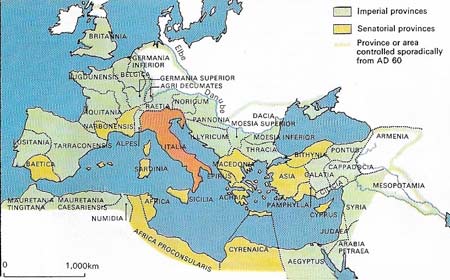
Figure 1. The Roman Empire, at its height in the 2nd century AD, was theoretically divided into provinces controlled by the Senate and the emperor. In reality, the emperor had the power to intervene in senatorial provinces. Italy itself was ruled according to a modified version of the republican constitution.
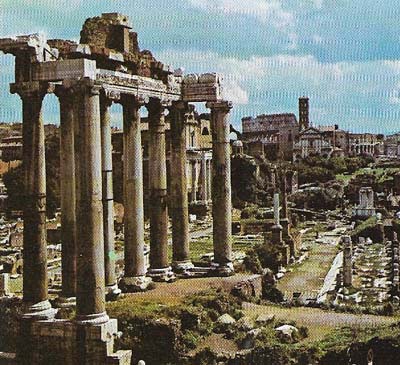
Figure 2. The Roman Forum (now in ruins) was the center of the government of the empire. Augustus and his successors symbolized their power in a series of impressive public buildings. The administration of all parts of the empire remained almost entirely in the hands of native Romans, who held both governorships and lesser posts until well into the 2nd century. Yet an increasing number of provincials succeeded in working their way up the administrative ladder, first from the western provinces and then from the eastern. By AD 200, 57% of the Senate were provincials.
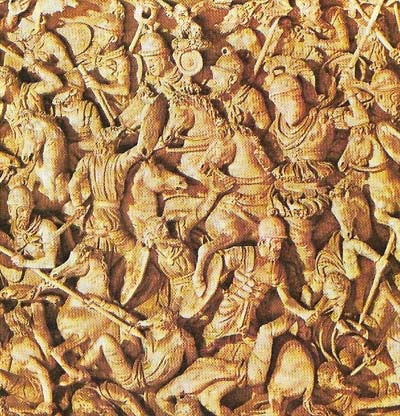
Figure 3. Legionaries and Germans were often at war in the 1st century, as seen in a contemporary relief. The empire failed to find secure frontiers and barbarian invasions played a major part in its collapse. In the relatively remote east a client state in Armenia usually provided a reasonable buffer against the Persian and Parthian empires, but in the west, far closer to the heart of the empire, constant vigilance was needed. Of the 28 legions established by Augustus more than half were always stationed in the provinces bordering the Rhine and Danube. Augustus attempted to gain the more easily defensible Elbe-Danube river line, but failed to secure it.
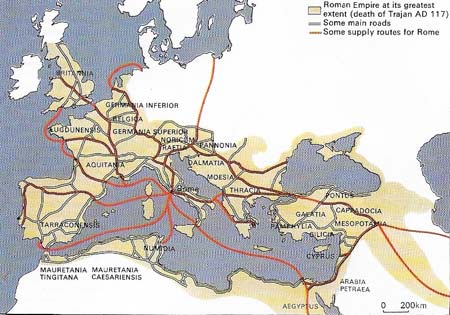
Figure 4. The networks of roads and sea routes that held the empire together was built to enable troops, tax collectors, and administrators to travel swiftly. But the great roads also allowed traders to cover the whole empire easily and the Roman world became an economic common market, with goods from one area available everywhere.
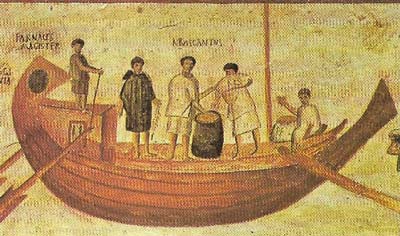
Figure 5. The loading of a Roman grain ship is shown in this picture. Egypt and North Africa were the granary of the empire and the importance of the grain trade, which provided a free ration for every citizen in the capital, was recognized by placing the trade directly under the personal control of the emperor.
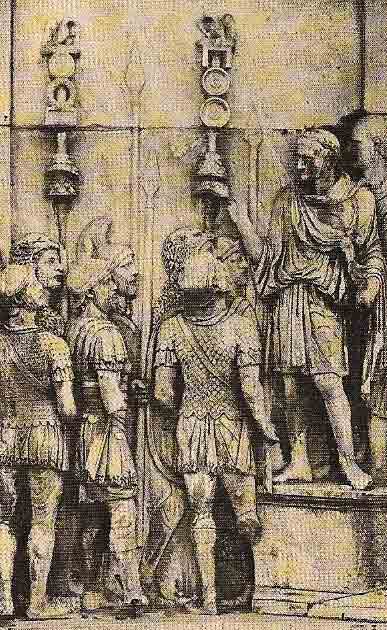
Figure 6. Marcus Aurelius, shown here addressing his troops, was a civilized, highly educated man and a staunch follower of the Stoic philosophy. He was fated to spend most of his reign struggling against the first great onrush of barbarians that threatened to overwhelm the empire. For the first time in centuries a foreign invader swept over the Alps into Italy and Aquileia was besieged. Only by conscripting every fit man, including gladiators and brigands, Was Marcus able to drive back the barbarians, restore the River Danube line and begin the work of reconquering Dacia. His reign marked the end of the enduring imperial peace.

Figure 7. The Emperor Augustus is shown here as Pontifex Maximus (High Priest). The state religion of the Roman Republic continued under the empire. The emperors were deified after their deaths and sometimes they were worshipped during their lifetimes by people in the Roman provinces. Other religions were tolerated as long as they accepted the divinity of the emperor, and many Eastern cults such as Mithraism or the worship of Isis, which provided greater mysticism and color, became popular. Only Judaism and Christianity, because they denied the divinity of the emperor, were in disfavor, but there was little direct persecution.
Octavian became the undisputed master of the Roman Republic and Empire following his victory over Mark Antony at the Battle of Actium in 31 BC. There is no doubt that he intended to establish a personal dynasty, but he was too clever a politician to ignore the strength of republican feeling in Rome. When he returned from the East in 29 BC he ostensibly restored the republic and set out to establish absolute power within it.
Augustus: "first among equals"
The Senate voted Octavian the honorary titles of "Princeps" (first citizen) and "Augustus", by which he was known thereafter (Figure 7). Additionally, he received consular status and the power of a tribune with the right to summon the Senate, introduce business, veto decisions, nominate candidates for elections and issue edicts. This was how Augustus was able to influence the government of Rome and Italy and put in hand massive development programs (Figure 2).
The government of the empire was divided between the older, settled provinces, governed by proconsuls elected by the Senate, and the newer, military provinces that were ruled through legates appointed by Augustus as a proconsul with special powers over all others (Figure 1). The army was reorganized under the emperor's direct control into a force of 28 legions of professionals recruited for 20–25 years. It was drawn from Roman citizens plus an equal number of auxiliaries enlisted from provincial territories. This system, of emperors ruling with the Senate, was to endure for more than 200 years.
The most important immediate task was to restore order to the empire and secure its frontiers. Augustus's first expeditions were to Gaul and Spain, each of which was reorganized into three provinces. The River Danube line was secured with a series of military provinces garrisoned by large legionary forces (Figure 3), and attempts were made from 12 BC to push forward across the Rhine to the Elbe. But the annihilation of three legions under Varus by the Germans in AD 9 forced Augustus to accept the Rhine as his boundary. In the east, peace was made with the Parthian Empire and a buffer state was established in Armenia. Internally, brigandage and piracy were stamped out and taxation and the administration of Roman law put on a uniform basis.
Augustus died in AD 14 and under his successor, Tiberius (reigned 14–37), his policies of establishing order were continued so well that the incompetence of Caligula (reigned 37–41) caused little lasting harm. Under Claudius (reigned 41–54) the conquest of Britain was begun and Mauretania (now Morocco and Algeria) was occupied.
Problems of succession
A major weakness of the Augustan imperial system was that the succession was never formulated and when in AD 68 the last of his direct house, the unstable Nero, was killed, four rival candidates for emperor were put forward by different sections of the army. Following a terrible civil war, Vespasian (reigned 69–79) was successful and developed a system whereby each emperor "adopted" his successor, thus giving the empire stability.
Under Trajan (reigned 98–117) the frontiers of the empire were again extended and Dacia, Armenia, and Mesopotamia were added; but the last two were abandoned by Hadrian (reigned 117–138). Hadrian concentrated on improving existing imperial defenses – building a wall across northern England and a fortified line between the Danube and the Rhine – and travelled throughout the empire inspecting the imperial administration and legal systems.
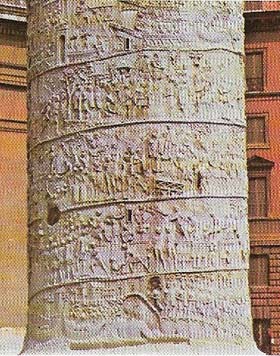 |
>
| Legionaries and their captives are shown here on Trajan's Column, a memorial in Rome to the Emperor's victories in Dacia. Trajan brought the empire to its largest extent with legions crossing the Danube into Dacia and down the Tigris and Euphrates to the Persian Gulf. But these areas were never fully pacified and their defense was a drain on the empire's military and financial resources. |
Peace and prosperity
Under the Antonine emperors (so called because of the family name of Hadrian's successor Antoninus) the empire was at its most peaceful. A man could travel in safety from Britain to Arabia along superb roads and secure seaways (Figure 4); trade flourished (Figure 5) and a single culture, two languages – Latin and Greek – and a single system of law and administration covered the whole empire. Great cities with fine public buildings grew up in the provinces, where the people strove to become Roman citizens.
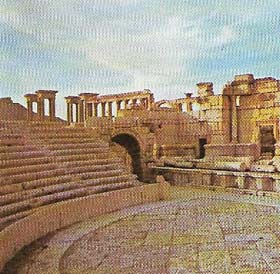 |
>
| The theater at Palmyra in Syria is typical of the fine buildings – temples, amphitheaters, aqueducts and baths – that were built in all the provinces of the empire. Just as they tolerated other religions, the Romans took care not to interfere with the social customs of the peoples they conquered. The civilizations of Greece and the East continued to flourish, but provincials were inevitably influenced by the example of Roman culture. |
There were, however, underlying weaknesses. Rome, had grown rich in booty and taxation from the provinces and economic activity tended to be one-way, with wealth and produce flowing to Rome but little produced in return. This caused jealousy in the provinces and an increasing idleness within Italy, problems made worse by the widespread use of slaves for all productive labor and a steady decline in the population. It became more and more difficult to find native citizens to undertake the many administrative and military duties on which the government of the empire depended. As a result an increasing number of provincials reached high administrative positions.
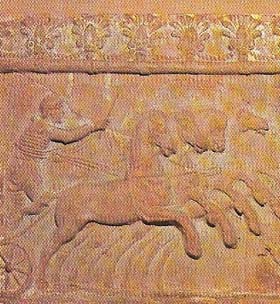 |
>
| Races – especially chariot races – and gladiatorial games became increasingly popular and important under the empire. Thus the emperor and rich patricians courted the popularity of the Roman mob by providing ever more lavish spectacles. The distribution of free bread and the frequency of free entertainments helped to insulate the Roman people from economic and political reality and played a major part in dissolving civic responsibility. |
Under Marcus Aurelius (reigned 161–180) (9) the peace ended. In the east a Parthian attack was defeated but the returning troops brought back a terrible plague which devastated the whole empire and further reduced its manpower. On the Rhine and Danube frontiers the barbarians were being forced forward by a massive migration of Goths in central Europe, and in 167 several tribes crossed the Danube and Alps and swept into Italy. Dacia was also overrun and Marcus spent the rest of his reign fighting to restore the frontiers.
